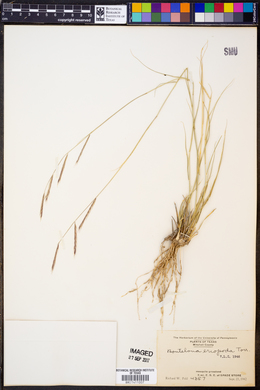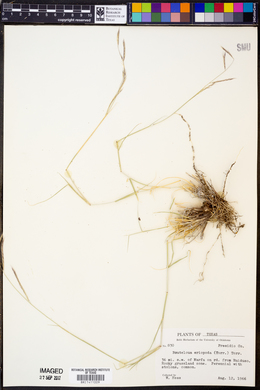Bouteloua eriopoda
|
|
|
|
Family: Poaceae
Black Grama, more... (es: navajita negra)
[Bouteloua brevifolia Buckley, moreChondrosum eriopodum Torr.] |
Plants perennial; often shortly rhizomatous, stoloniferous, stolons long, densely woolly-pubescent. Culms 20-60(75) cm, wiry, decumbent, rooting at the lower nodes; lower internodes densely woolly-pubescent. Sheaths mostly glabrous or sparsely pilose, usually pilose near the ligules; ligules 0.1-0.4 mm, of hairs; blades 2.5-6 cm long, 0.5-2 mm wide, scabrous adaxially, margins with papillose-based hairs basally. Panicles (1)2-16 cm, with (1)2-8 branches; branches 14-50 mm, persistent, densely woolly-pubescent basally, with 8-18 spikelets, axes terminating in entire, sometimes scarious apices; disarticulation above the glumes. Spikelets pectinate, with 1 bisexual floret and 1 rudimentary floret. Glumes unequal, smooth or scabrous; lower glumes 2-4.5 mm; upper glumes 4.5-8(9) mm, glabrous, scabrous, or withhairs, hairs to 0.5 mm, not papillose-based; lower lemmas 4-7 mm, pubescent basally, glabrous or sparsely puberulent distally, acuminate, central awns 0.5-4 mm, lateral awns absent or shorter than 1 mm; lower paleas acuminate, unawned; anthers 1.5-3 mm, yellow to orange; rachilla segment to second florets about 2 mm, with a distal tuft of hairs; upper florets rudimentary, an awn column terminating in 3 awns of 4-9 mm. Caryopses 2.5-3 mm. 2n = 20, 21, 28. Boutloua eriopoda grows on dry plains, foothills, and open forested slopes, often in shrubby habitats, and also in waste ground. It is usually found between 1000-1800 m, but extends to 2500 m. Once a dominant in much of its range, under heavy grazing B. eriopoda persists only where protected by shrubs or cacti because it is highly palatable. Its range extends from the southwestern United States to northern Mexico. Dr. David Bogler, USDA NRCS PLANTS Database Perennials, Terrestrial, not aquatic, Rhizomes present, Rhizome short and compact, stems close, Stolons or runners present, Stems nodes swollen or brittle, Stems geniculate, decumbent, or lax, sometimes rooting at nodes, Stems terete, round in cross section, or polygonal, Plants conspicuously hairy, grayish, or wooly, Stem internodes hollow, Stems with inflorescence less than 1 m tall, Stems, culms, or scapes exceeding basal leaves, Leaves mostly basal, below middle of stem, Leaves conspicuously 2-ranked, distichous, Leaves sheathing at base, Leaf sheath mostly open, or loose, Leaf sheath smooth, glabrous, Leaf sheath hairy at summit, throat, or collar, Leaf sheath and blade differentiated, Leaf blades linear, Leaf blad es very narrow or filiform, less than 2 mm wide, Leaf blades mostly flat, Leaf blade margins folded, involute, or conduplicate, Leaf blades mostly glabrous, Leaf blades scabrous, roughened, or wrinkled, Ligule present, Ligule a fringe of hairs, Inflorescence terminal, Inflorescence with 2 or more spikes, fascicles, glomerules, heads, or clusters per culm, Inflorescence a panicle with narrowly racemose or spicate branches, Inflorescence with 2-10 branches, Inflorescence branches 1-sided, Inflorescence branches terminating in bristle or point, Flowers bisexual, Spikelets sessile or subsessile, Spikelets laterally compressed, Spikelet less than 3 mm wide, Spikelets with 1 fertile floret, Spikelets solitary at rachis nodes, Spikelets all alike and fertille, Spikelets bisexual, Spikelets disarticulating above the glumes, glumes persistent, Spikelets secund, in rows on one side of rachis, Rachilla or pedicel glabrous, Glumes present, empty bracts, Glumes 2 clearly present, Glumes distinctly unequal, Glumes equal to or longer than adjacent lemma, Glume equal to or longer than spikelet, Glumes 1 nerved, Lemma coriaceous, firmer or thicker in texture than the glumes, Lemma 3 nerved, Lemma glabrous, Lemma body or surface hairy, Lemma apex acute or acuminate, Lemma mucronate, very shortly beaked or awned, less than 1-2 mm, Lemma distinctly awned, more than 2-3 mm, Lemma with 1 awn, Lemma awn less than 1 cm long, Lemma margins thin, lying flat, Lemma straight, Palea present, well developed, Palea membranous, hyaline, Palea shorter than lemma, Palea 2 nerved or 2 keeled, Stamens 3, Styles 2-fid, deeply 2-branched, Stigmas 2, Fruit - caryopsis, Caryopsis ellipsoid, longitudinally grooved, hilum long-linear.
FNA 2003, Gould 1980 Common Name: black grama Duration: Perennial Nativity: Native Lifeform: Graminoid General: Perennial, often rhizomatous, grass with long densely woolly-pubesent stolons; stems 20-60 cm, wiry, decumbent and rooting at lower nodes; lower internodes densely woolly-pubescent. Vegetative: Sheaths glabrous to sparsely pilose, pilose near ligules; leaves inconspicuous with sheaths mostly shorter at internodes, blades 2 mm or less broad, 2-6 cm long, margins with papillose-based hairs; ligule < 0.5 mm, ciliate. Inflorescence: Panicles 2-16 cm, with 2-8 branches; branches 1-5 cm, densely woolly-pubescent basally, with 8-18 spikelets, branch axes terminating in entire, scarious apices; disarticulation above the glumes; spikelets moderately pectinate along branch, each with 1 bisexual floret and 1 rudimentary floret; glumes unequal, smooth or glabrous, 6-9 mm long; fertile lemma bearded at base, otherwise glabrous, tapering above to stout terminal awn mostly 1-3 mm long and much reduced lateral awns; rudimentary floret reduced to a lemma with 3 long awns, these 4-8 mm long. Ecology: Dry sandy plains, foothills, rocky slopes, forested slopes, often in shrubby habitats and in waste ground from 3500-8500 ft (1067-2591 m); flowers July to October. Distribution: se CA, s NV, s UT, AZ, NM, s CO and w TX; n MEX. Notes: Distinguished by its erect to laying-down (decumbent) growth form; spreading and wiry stems rhizomes, and often long stolons, which are woolly. A quite useful diagnostic character when the plant is matured and dry are the dark colored internodes covered by silvery-pubescence, alternating along the stem with the straw-colored, non-hairy leaf sheaths; when fresh, the internodes are green and covered with silvery pubescence, and the leaf sheaths are green and non-hairy. Also helpful are the 14-50 mm long inflorescence branches which have tufts of hair at the bases and are relatively slender when compared with other perennial Boutelouas. Each spikelet has 3 awns emerging from it, making them reminiscent of an Aristida. This highly-palatable grass often decreases with high grazing pressure and dense stands can be indicative of healthy rangelands. Ethnobotany: Unknown, but other species in the genus have many uses. Etymology: Bouteloua named for brothers Claudio (1774-1842) and Esteban (1776-1813) Boutelou Agraz, Spanish botanists and horticulturalists; eriopoda means woolly-footed. Synonyms: Chondrosum eriopodum Editor: SBuckley 2010, FSCoburn 2014, AHazelton 2015 |
|
|
|
































































































